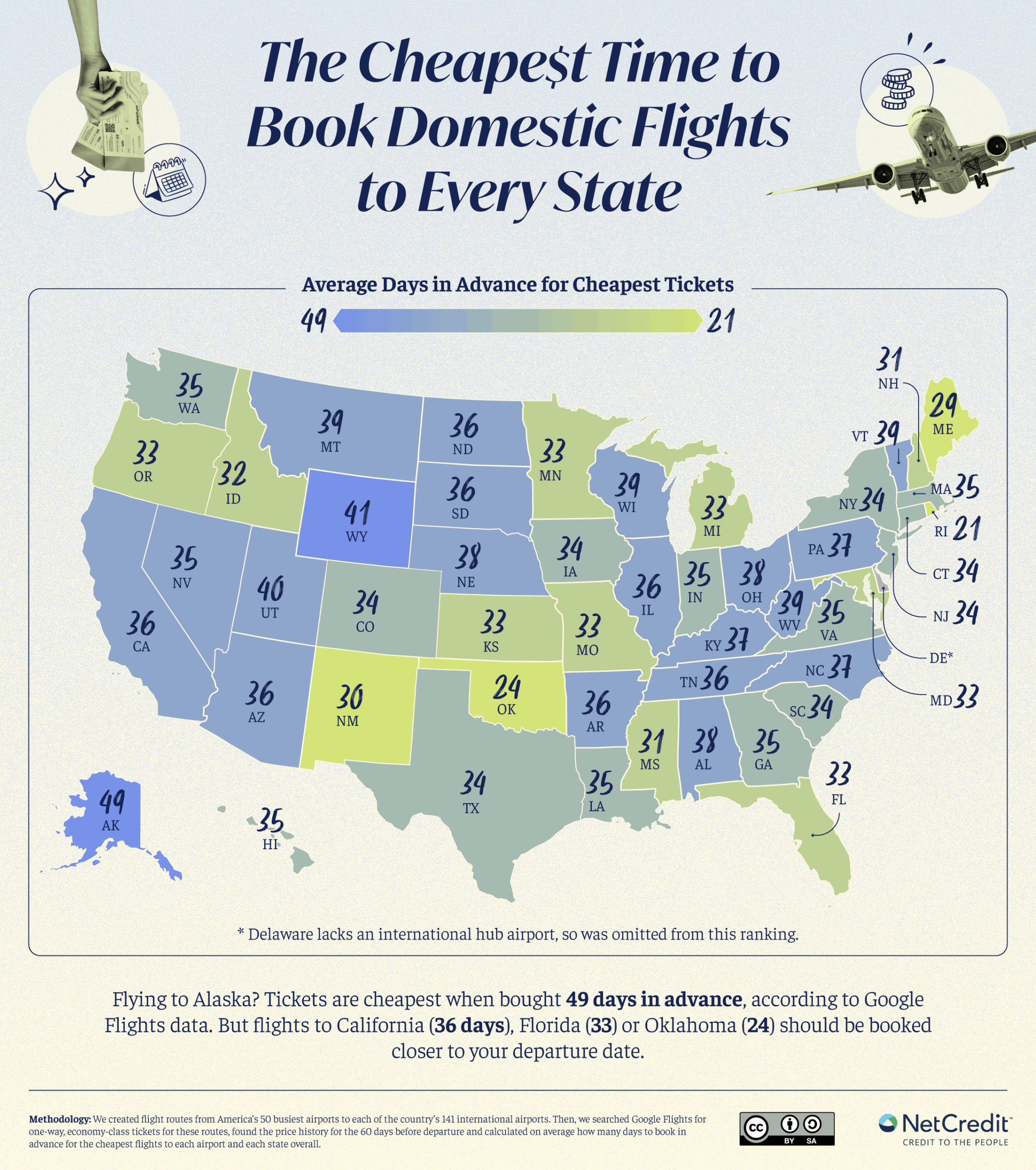A changeable economy, concerns over safety and the new Real ID rules have led to a fall in demand for domestic flight tickets, and prices have followed. In March this year, airfares were 5.3% lower than March 2024 levels and 12.1% lower than a decade ago.
But even though airfare prices are lower in general, it’s still prudent to shop around for the best deal, particularly if you are trying to stick to a budget. Services like Kayak and Google Flights offer price tracking and comparisons between airlines; Google suggests that the “historical low price range is 21-52 days before takeoff” for domestic flights.
To help you find the best point in that window to book your domestic flight, we analyzed Google Flights data and mapped the ideal advance booking period to each state. We also created a searchable table of the recommended period to book flights to 141 of America’s most vital hub airports.
Key Findings
- When booking flights to Alaska, it’s best to book 49 days in advance — the longest planning period for any state.
- Rhode Island is the best state for late bookings, with the cheapest tickets available 21 days in advance of travel on average.
- It’s generally best not to wait until the month that you are traveling — tickets to 34 out of 50 states are cheapest from 30 to 40 days in advance.
Flights to Alaska are best booked nearly two months in advance
If you’re thinking of booking a domestic flight to Alaska, it’s best to book around 49 days in advance. This is the longest advance booking period for travel to any state and more than twice the period recommended for booking to Rhode Island or Oklahoma. Note that when flying on Alaska Airlines, it may be possible to exchange an expensive ticket for a cheaper flight or call up to get a credit if you find your flight has gotten cheaper since you booked — as long as you didn’t book the Saver Fare.
 Rhode Island has the shortest turnaround time between the cheapest fares and takeoff: just 21 days. However, it is worth tracking prices ahead of that 21-day sweet spot since Google’s data suggests general trends rather than a hard and fast rule — such as the old idea that the cheapest flights are made available on Tuesdays. In reality, airfare pricing can be more volatile:
Rhode Island has the shortest turnaround time between the cheapest fares and takeoff: just 21 days. However, it is worth tracking prices ahead of that 21-day sweet spot since Google’s data suggests general trends rather than a hard and fast rule — such as the old idea that the cheapest flights are made available on Tuesdays. In reality, airfare pricing can be more volatile:
“Twenty-plus years ago, airlines used to load their schedules onto the internet once a week so that Tuesday myth might have been true then,” says Katy Nastro, spokesperson for Going (formerly Scott’s Cheap Flights). “[B]ut these days, algorithms are so much more sophisticated. They don’t load their fares once a week, they do it in real time.”
The best time to book flights to each U.S. hub airport
Next, we arranged our findings into the interactive table below. You can use the search box and arrows to find how long in advance to book travel to each state and compare the options where multiple hub airports operate in your destination state.
For example, it’s best to book 33 days in advance to travel to Kansas, but the optimal booking time varies between 30 and 40 days depending on whether you arrive at Louisville Muhammad Ali International Airport (30 days), Blue Grass (38) or Cincinnati/Northern Kentucky International (40). Similarly, we analyzed pricing for eight hub airports in New York, and the best booking time on average is 34 days in advance — but if you’re heading for Albany International, it may be wisest to wait until 27 days before takeoff.
7 ways to save money on domestic air travel
Oftentimes, the high price of airfares is the cost of convenience — booking what you want, when you want and with little hassle. But if you’re prepared to be flexible and do some research, savings can be made. Here are our top tips for keeping your travel bill down when flying domestically.
- Use a flight comparison tool such as Kayak, Google Flights or Kiwi to compare prices from multiple airlines — and set up price alerts to receive emails when an airfare drops.
- If you can be flexible in your choice of dates, you’re more likely to find a bargain. Choosing to fly on an off-day or from a cheaper airport can help you keep costs low.
- Book your car park spot in advance — or leave the car at home and use public transit.
- Adjust your advance booking period for holiday seasons. The cheapest tickets for Christmas, Thanksgiving and the summer vacation period tend to get snapped up quickly.
- Already booked and seen a better price? Check if the airline you booked with offers to credit the difference when you change to a cheaper flight or seat.
- Planning to rent a car at the other end? Again, booking early in advance can net you the best choice and price.
- Compare and contrast prices for flights from different airlines, prioritizing those that offer the cheapest prices for domestic flights.
The outlook for air travelers looks promising as airfares continue to fall in general. But it is still worth planning long in advance to book your tickets, as airlines may respond to falling demand by reducing the number of flights available — potentially pushing prices back up towards 2024 levels. When even United Airlines claims it’s “impossible to predict this year with any degree of confidence,” it falls to the traveler to make the most of the pricing tools that are available.
Methodology
We analyzed pricing data from Google Flights to discover how many days you need to book in advance to get the cheapest flights to every international airport in the U.S.
First, we created flight routes from America’s 50 busiest airports to each of the 141 recognized international airports in the country.
We then searched for one-way tickets (economy class) for these routes and consulted the price history, which reveals what the price was for that flight up to 60 days before departure.
Repeating this process for all 50 flight routes to each airport, we calculated on average how many days you should book in advance for the cheapest flights.
Finally, we aggregated data for airports in the same states to determine the optimum number of days to book in advance for flights to every state.
(Note: Delaware lacks an international hub airport, so it was omitted from state rankings.)
Data is correct as of March 2025.
DISCLAIMER: This content is for informational purposes only and should not be considered financial, investment, tax or legal advice.






